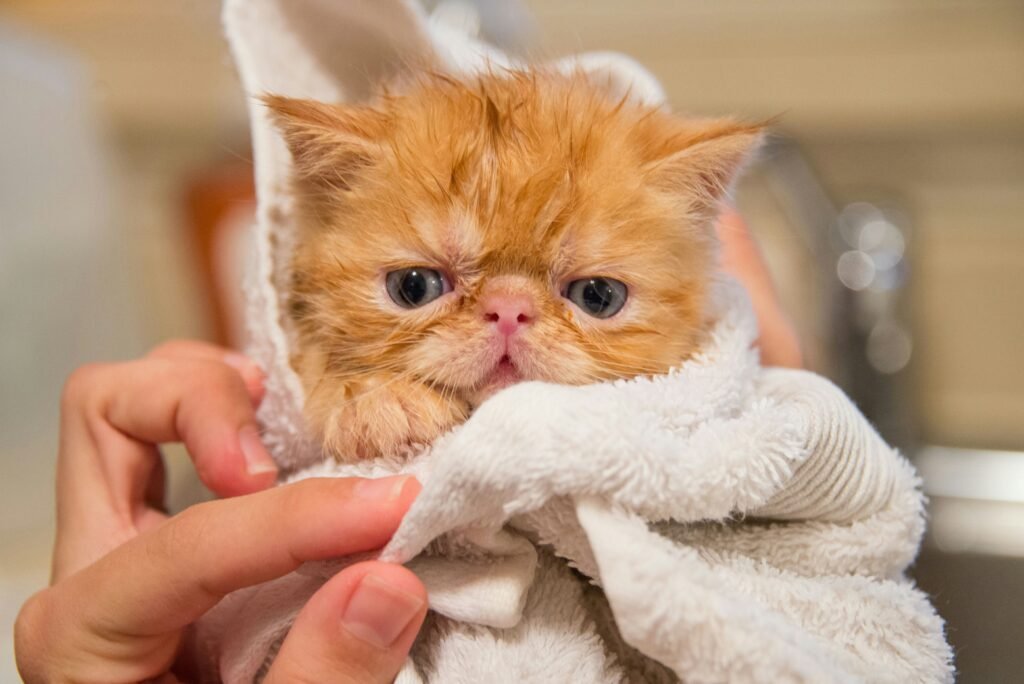
Bathing a cat is a task that can strike fear into the hearts of many pet owners. Cats are known for their strong dislike of Water, and the idea of coaxing them into a bath can seem daunting. The good news is that with the right preparation, approach, and understanding of how to bathe a cat, the experience can be manageable and even positive for you and your furry friend.
Many cat owners avoid bathing their cats because they worry about stressing them out. However, there are times when bathing your cat is necessary. Maybe they got into something dirty or smelly or have a skin condition requiring a medicated bath. In these cases, knowing how to bathe your cat properly can make a big difference.
This guide is here to help, whether you’re a seasoned cat owner or wondering how to wash your cat for the first time. We’ll cover everything you need to know, from gathering the right supplies to making the bath as stress-free as possible. With the right tips and tricks, you’ll find that bathing your cat can be much easier than you thought. By the end of this guide, you’ll feel confident and ready to give your cat a bath that leaves them clean and happy.
Why Learning How to Bathe Your Cat is Important
While cats do a good job grooming themselves, there are times when you need to step in. Knowing how to bathe your cat in these situations can keep them healthy and happy.
Here are some reasons why you might need learn how to bathe your cat:
1. Health Conditions
Some health conditions require bathing as part of the treatment. For example, if your cat has ringworm or a severe flea infestation, a medicated bath can help. These baths kill the parasites and heal the skin. Always follow your vet’s instructions on how to bathe your cat in these cases.
2. Accidents
Cats sometimes get into messy situations. They might roll in something sticky or get covered in a harmful substance. If such a situation happens, bathing is the best way to clean them up. Removing these substances can quickly prevent them from ingesting anything harmful while grooming themselves.
3. Allergies
Bathing your cat can help reduce allergens. Cats can carry pollen, dust, and other allergens in their fur. Regular baths can help wash these away. This can make life easier for your cat and anyone in your home with allergies.
4. Old Age or Obesity
Older cats or overweight cats might struggle to groom themselves properly. They may have difficulty reaching certain areas of their bodies, leading to dirty or matted fur. Giving them a bath can help keep their coat clean and healthy.
How to Bathe Your Cat – Preparation

Preparation is key to ensuring a successful bath. Before you even turn on the Water to bathe your cat, here are some steps to follow.
By following these preparation steps, you can make the experience of how to bathe your cat much smoother and more pleasant for both you and your feline friend. Proper preparation ensures that you are ready to handle any challenges that may arise during the bath and helps your cat feel more secure and comfortable.
1. Gather Your Supplies
Having everything you need within arm’s reach will help the process go smoothly and reduce stress for you and your cat. Here’s a list of essential items:
- Cat-specific shampoo: Never use human shampoo, as it can irritate your cat’s skin. Cat shampoos are specially formulated to be gentle and safe.
- Brush or comb: Remove any tangles or mats before bathing. Brushing your cat beforehand helps make the bath more effective.
- Non-slip mat: Place a non-slip mat in the sink or tub to prevent your cat from slipping. This makes your cat feel more secure.
- Cup or gentle spray nozzle: Use a cup or a gentle spray nozzle to rinse your cat. This helps you control the water flow and avoid scaring your cat.
- Towels: Have a couple of towels ready to dry your cat afterward. A large towel can wrap your cat, and a smaller one can pat them dry.
- Treats: Keep some treats nearby to reward and calm your cat during and after the bath. Treats make the experience more positive for your cat.
2. Trim Your Cat’s Nails
Cats may scratch if they become frightened, so trimming their nails beforehand is a good idea. Be sure to use proper cat nail clippers and avoid cutting too close to the quick, which is the pink part inside the nail that contains blood vessels and nerves. Trimming the nails will help protect you and make your cat more comfortable.
3. Brush Your Cat
Brushing your cat before a bath helps remove loose fur and detangle any mats. Mats can become tighter and more painful when wet, making them harder to deal with. A thorough brushing session will make the bath easier and more effective.
4. Choose the Right Time
Choose a time when your cat is calm and less likely to be agitated. After a meal or a play session, your cat is usually more relaxed and tired, making it an ideal time for a bath. A relaxed cat is less likely to resist or become stressed during the bath.
How to Wash Your Cat for the First Time

Bathing your cat for the first time requires extra care and patience. Here’s a step-by-step guide to make the process as stress-free as possible:
Step 1: Introduce Your Cat to Water Gradually
Before the actual bath, let your cat get used to the idea of Water. Here’s how to do it:
- Start Slow: Place your cat in an empty sink or tub. Let them explore this new space without any water. Offer treats and gentle petting to create a positive association.
- Add Water Gradually: After your cat seems comfortable in the empty sink or tub, slowly introduce a small amount of Water. Let them feel the Water on their paws and continue to offer treats and praise. This slow introduction of Water helps them get used to the sensation without feeling overwhelmed.
Step 2: Use Lukewarm Water
The temperature of the Water is crucial for your cat’s comfort:
- Fill the Sink or Tub: Fill the sink or tub with lukewarm Water. The Water should be shallow enough to wet your cat’s body but not too deep to cause anxiety. Lukewarm Water is soothing and less likely to startle your cat than cold or hot Water.
Step 3: Wet Your Cat
Getting your cat wet requires a gentle approach:
- Place Your Cat in the Water: Gently place your cat in the Water. Use one hand to support their body and the other to pour Water using a cup or a gentle spray nozzle. Avoid wetting their head. Speak in a calm, soothing voice to reassure your cat. Your support helps them stay relaxed during the process.
Step 4: Apply Cat Shampoo
Using the right shampoo and technique is important:
- Choose Cat-Specific Shampoo: Apply a small amount of cat-specific shampoo. Never use human shampoo, as it can irritate their skin.
- Lather Gently: Lather the shampoo into their fur, carefully avoiding their face, ears, and eyes. Work the shampoo in gently to clean their fur and skin. Follow the instructions on the shampoo bottle for the best results.
Step 5: Rinse Thoroughly
Rinsing is a critical step to ensure all shampoo is removed:
- Use a Cup or Spray Nozzle: Rinse your cat thoroughly to remove all the shampoo. Any residue left can irritate their skin. Use the cup or spray nozzle to ensure all the soap is washed out. Make sure to rinse well, especially under the legs and belly.
Step 6: Dry Your Cat
Drying your cat properly helps keep them comfortable after the bath:
- Lift and Towel Dry: Gently lift your cat out of the Water and wrap them in a towel to remove excess Water. You may need to use several towels to get them as dry as possible.
- Consider a Blow Dryer: Some cats tolerate a blow dryer set on low, but many prefer to air dry. If using a blow dryer, keep it on a low, warm setting and hold it at a distance to avoid overheating or frightening your cat.
- Warm, Draft-Free Room: Let your cat air dry in a warm, draft-free room. This will keep them comfortable and help them dry more quickly.
By following these steps, you can learn how to bathe your cat with care and patience, making the experience less stressful for both of you. With practice and positive reinforcement, your cat will become more accustomed to baths, and the process will become easier over time.
Tips for a Stress-Free Bathing Experience
Bathing your cat can be challenging, but these tips can help make the experience smoother and less stressful for you and your cat.
Here’s how to bathe your cat with ease:
Stay Calm
Cats can sense your anxiety, so staying calm and confident is important. Your cat will pick up on your mood; if you are calm, they are more likely to stay calm, too. Take deep breaths and move slowly and gently.
Keep It Short
The quicker the bath, the less stressful it will be for your cat. Aim to get through the bathing process as efficiently as possible. Have everything you need within reach before you start to avoid unnecessary delays. Such a preparation and quick bath helps keep your cat from becoming too anxious.
Use a Helper
Having a second person to assist you can make a big difference. One person can hold and comfort the cat while the other bathes. Having another person makes it easier to manage your cat and ensures that you have an extra pair of hands to help if needed.
Reward Your Cat
Rewarding your cat during and after the bath helps create a positive association with the experience:
- Treats: Offer treats throughout the process. Give your cat a treat when they are calm and cooperative. This reinforces good behavior and helps distract them.
- Praise: Use a soothing voice to praise your cat. Gentle words and a calm tone can help keep them relaxed.
- Affection: Pet and cuddle your cat after the bath to show them they did well. Your affection helps them feel secure and loved.
By following these tips, you can learn how to bathe your cat in a way that minimizes stress and makes the process more manageable. With practice, your cat will become more accustomed to baths, and it will become a routine part of their care.
Post-Bath Care

After the bath, your cat may need some time to recover from the experience. Here’s how you can help them:
- Provide a Warm Space: Ensure your cat has a warm, comfortable place to dry off and rest. This place helps them feel safe and secure after the bath.
- Dry Towels: Place a few dry towels in a cozy spot where your cat likes to relax. This will help them stay warm and dry off more quickly.
- Warm Room: Keep your cat in a warm, draft-free room. A slightly heated room can be especially comforting if the weather is cool.
Offer Treats and Praise
Continue to reward your cat with treats and praise to reinforce the positive experience. This helps them associate baths with good things.
- Treats: Give your cat a few treats after the bath. This rewards their patience and cooperation.
- Praise: Use a soothing voice to praise your cat. Tell your cat that it did a good job, and give your cat a gentle petting. This reinforcement helps reassure your cat and makes it feel loved.
Monitor for Stress
Watch for signs of stress or anxiety in your cat. If they seem particularly distressed, it might be best to avoid future baths unless absolutely necessary.
- Signs of Stress: Look for signs like hiding, excessive grooming, or a behavior change. If your cat acts differently after the bath, they might be stressed.
- Future Baths: If your cat seems very stressed, consider alternatives to bathing, like using pet wipes or dry shampoo. Only bathe your cat when absolutely necessary to avoid causing them undue stress.
By providing post-bath care, you help your cat recover from the experience and reinforce a positive association with bathing. Knowing how to bathe your cat and care for them afterward ensures they stay clean and healthy without too much stress.
Alternative Cleaning Methods
If your cat is particularly averse to Water, alternative methods exist to keep them clean. These options can be effective and less stressful for your cat. Here’s how to bathe your cat without using Water:
1. How to Bathe your Cat Using Dry Shampoo
Dry shampoos designed for cats can help clean their fur without the need for Water. They are easy to use and can be a great alternative to traditional baths.
- How to Use: Apply the dry shampoo to your cat’s fur as the product label directs. Usually, you need to sprinkle or spray it onto the cat’s coat.
- Brush It Out: After applying the dry shampoo, brush your cat’s fur thoroughly to remove the product and any dirt. Brushing helps clean the coat and leaves it smelling fresh.
- Benefits: Dry shampoo is quick and easy to use and avoids the stress of a water bath.
2. How to Bathe your Cat with Cat Wipes
Cat grooming wipes are another option. These wipes are designed to clean and freshen your cat’s coat without Water.
- How to Use: Take a cat grooming wipe and gently rub it over your cat’s fur. Focus on areas that tend to get dirty, like their paws, face, and underbelly.
- Gentle and Safe: Make sure to use wipes that are specifically made for cats. These wipes are gentle on their skin and safe if they lick their fur afterward.
- Benefits: Cat wipes are convenient and can be used anytime to clean your cat quickly. They are especially useful for spot cleaning.
3. Regular Brushing
Regular brushing can help keep your cat’s fur clean and reduce the need for frequent baths. It also helps distribute natural oils throughout their coat, keeping it healthy and shiny.
- How to Brush: Use a brush suitable for your cat’s fur type. Gently brush in the direction of the fur to remove loose hair, dirt, and tangles.
- Frequency: Brush your cat regularly, at least a few times a week. Long-haired cats may need daily brushing to prevent mats and tangles.
- Benefits: Regular brushing helps maintain your cat’s coat, reduces shedding, and strengthens your bond with your cat.
Using these alternative methods, you can keep your cat clean without the stress of a traditional bath. Learning how to bathe your cat using dry shampoo, grooming wipes, or regular brushing can make grooming a more pleasant experience for you and your cat.
When to Seek Professional Help

Sometimes, it might be best to seek professional help bathing your cat. Professional groomers are experienced in handling cats and can thoroughly clean them with minimal stress. Here’s when you should consider professional grooming and how to bathe your cat safely with expert help:
Severe Matting or Skin Conditions
If your cat has severe matting or skin conditions that require special care, it’s best to consult a professional groomer.
- Matting: Severe mats can be painful for your cat and difficult to remove without proper tools and techniques. A groomer can safely and gently remove these mats.
- Skin Conditions: If your cat has a skin condition, like ringworm or dermatitis, a professional groomer can use the appropriate medicated shampoos and treatments. They have the expertise to handle these conditions without causing further irritation.
Inability to Bathe Safely at Home
If you find it difficult to bathe your cat safely at home, a professional groomer can help.
- Handling Issues: Some cats are very squirmy or resistant to being handled during a bath. Groomers are trained to manage these situations safely.
- Equipment: Professional groomers have specialized equipment that makes bathing more efficient and less stressful for your cat.
Extreme Stress or Aggression
If your cat becomes extremely stressed or aggressive during baths, it’s wise to seek professional help.
- Stress Management: Groomers know how to keep cats calm during grooming sessions. They can use techniques and tools that reduce stress and make the experience more comfortable.
- Safety: Aggressive behavior during a bath can lead to scratches or bites for you and your cat. Groomers are trained to handle aggressive cats safely, ensuring no one gets hurt.
Knowing when to seek professional help can ensure your cat gets the care they need without unnecessary stress or risk. If you’re unsure how to bathe your cat or if it becomes too challenging, don’t hesitate to contact a professional groomer. They can provide expert care and make the grooming process a positive experience for your cat.
Conclusion
Learning how to bathe your cat can be valuable for any cat owner. While it may seem challenging, it can be done successfully with the right preparation and approach.
Remember to stay calm, be patient, and reward your cat throughout the process. Whether you’re washing your cat for the first time or it’s a routine part of your cat’s care, these tips and techniques will help make the experience as smooth and stress-free as possible.
By understanding your cat’s needs and taking the time to prepare, you can ensure that bath time is a positive experience for both you and your feline friend.


